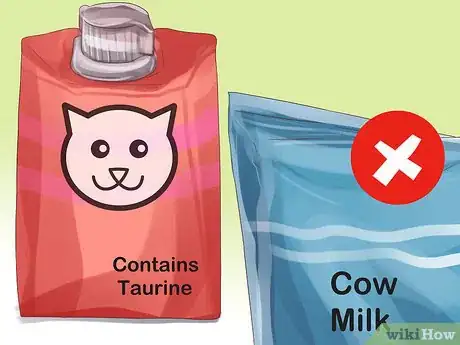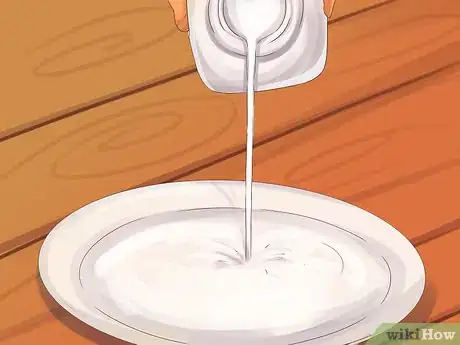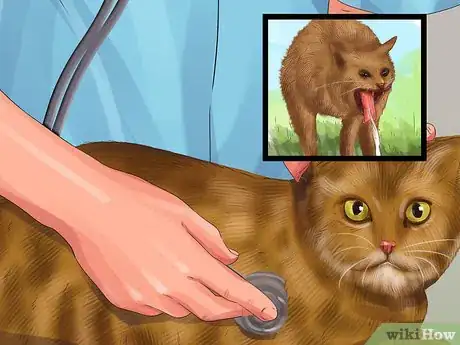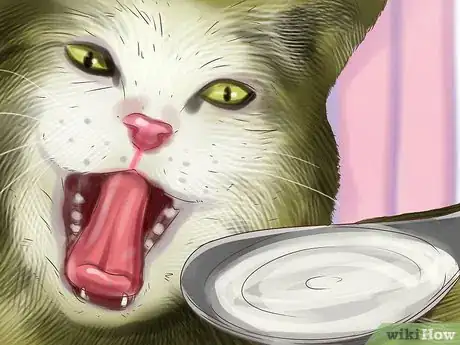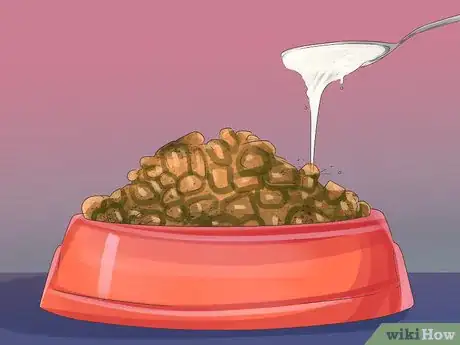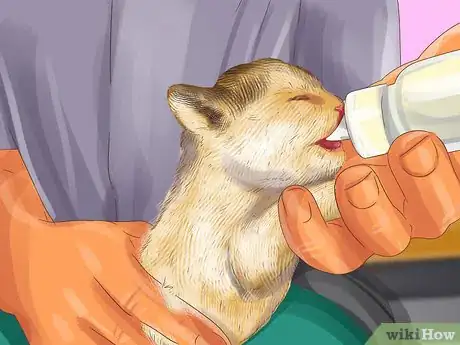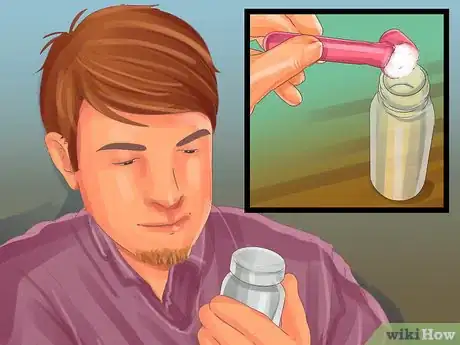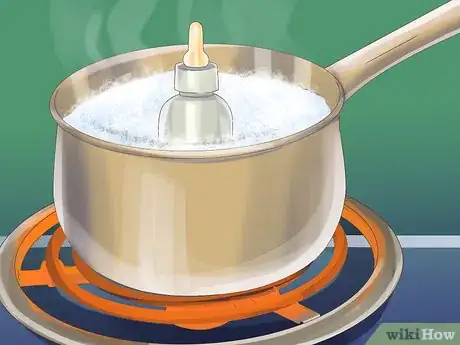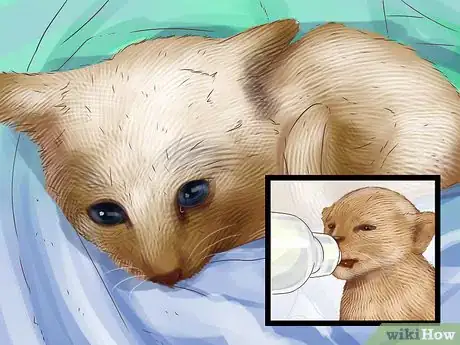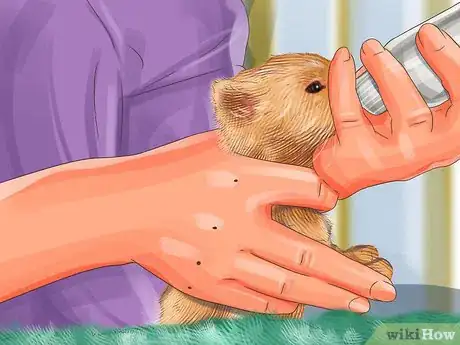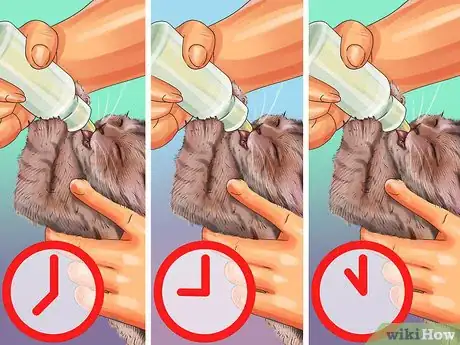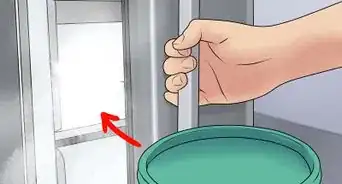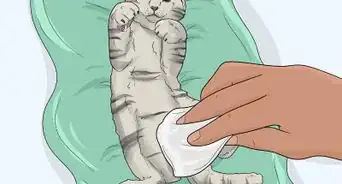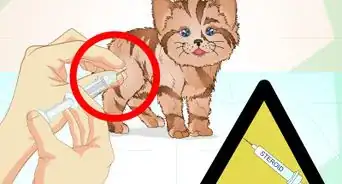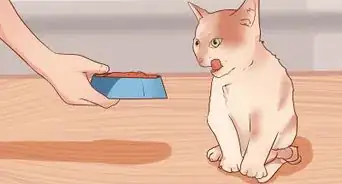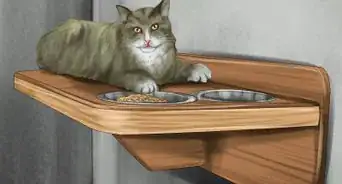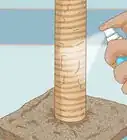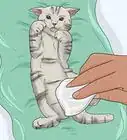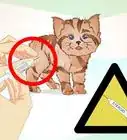This article was co-authored by Pippa Elliott, MRCVS. Dr. Elliott, BVMS, MRCVS is a veterinarian with over 30 years of experience in veterinary surgery and companion animal practice. She graduated from the University of Glasgow in 1987 with a degree in veterinary medicine and surgery. She has worked at the same animal clinic in her hometown for over 20 years.
This article has been viewed 19,681 times.
When giving cat milk to your cat, make sure to use specially formulated milks that are lactose-free. You can give cat milk to your cat as a reward, to make its dry food more enticing, and to encourage the weaning process. If your cat has any adverse reactions to the milk, make sure to consult your veterinarian.
Steps
Administering the Cat Milk
-
1Use specially formulated milk. Specially formulated cat milks are lactose-free. Choose a cat milk that is enriched with taurine—an essential amino acid that is required for heart and eye health. You can find specially formulated milks at your local pet store, or ask your veterinarian.[1]
- Because the majority of adult cats are lactose intolerant, do not give your cat cow’s milk.
- You may give your cat organic, lactose-free "people" milk as well. However, start with a small dose, like a teaspoon, to make sure there are not any negative side effects first.
- Do not feed your cat soy milk.
-
2Pour the milk onto a saucer. Administer the milk per the instructions on the bottle. Because cat milk does not keep for long, make sure to discard any remaining milk after 45 minutes. This way you can prevent your cat from eating spoiled milk.[2]Advertisement
-
3Remember that cat milk contains calories. You will need to balance the amount of cat milk your cat eats with its other foods, such as wet food or kibble. Adding cat milk to your cat's diet without considering the overall amount of calories that your cat is consuming could cause your cat to become overweight.
- If your cat is overweight, you will need to cut back on its other foods to offset the calories added by the cat milk.
-
4Consult your veterinarian. If your cat experiences diarrhea, vomiting, and/or bloating after drinking the milk, then refrain from giving it more milk. Make sure to take your cat to the vet if it experiences any of these symptoms.[3]
Deciding When to Offer It Cat Milk
-
1Give the milk as a reward. If you want to reward your cat, cat milk is considered a healthy alternative to treats. Give your cat a teaspoon of cat milk as a reward.[4]
- Make sure to count the milk as a part of its daily food intake to avoid overfeeding your cat.
-
2Mix it with solid food. Mixing your cat’s dry food with cat milk can entice your cat to eat its dry food. Mix a teaspoon of cat milk with your cat’s dry food to encourage your cat to eat.
-
3Wean your kitten with cat milk. Adult female cats begin to wean their kittens around seven to eight weeks of age. If your adult cat is having trouble weaning its kitten, then feed the kitten specially formulated cat milk to encourage the weaning process.
Feeding Milk to a Kitten
-
1Mix the formula. Mix the formula per the instructions on the packaging. Make sure to follow the directions closely. Pour the mixture into a bottle specifically designed for kittens.[5]
- You can purchase powdered formulas, as well as a bottle and teat set, from your local pet store or veterinarian.
- Always make the formula fresh.
-
2Warm the bottle. Fill a pot with one to two cups of water. Place the bottle in the pot, and then place the pot on the stove. Set the heat to medium. Remove the bottle once it feels warm, i.e., five to eight minutes.[6]
- Before feeding your kitten, test the temperature of the milk by squeezing a few drops onto your inner wrist. The temperature of the milk should be body temperature or slightly above room temperature. If it is too hot, then let it cool down.
-
3Place the kitten on a towel on your lap. Make sure the kitten is lying flat on its stomach. Entice your kitten to suckle by turning the bottle upside down. This will enable a drop of formula to come out so the kitten can smell it.[7]
- Never feed a kitten on its back.
- Make sure your kitten is warm before feeding it, i.e., 96 to 100 degrees Fahrenheit. If not, then warm your kitten with a heating pad before feeding it.
-
4Hold the bottle at a 45-degree angle. Place the bottle's nipple into your kitten's mouth. Gently move the nipple back and forth in your kitten's mouth to encourage it to eat. Once your kitten latches on, let it eat at its own pace.[8]
- Try not to fill your kitten's mouth with milk. This may cause your kitten to breathe in the milk, which can cause pneumonia.
-
5Feed your kitten every two to three hours. In general, kittens should eat eight milliliters of formula per ounce of body weight each day. Divide the amount of formula by the number of feedings to determine how much formula to feed your kitten at each feeding.[9]
- For example, a kitten that weighs five ounces should be given 40 milliliters of formula per day. Divide 40 by 7 (number of feedings if you are feeding your kitten every three hours) to get a total of 5.7 milliliters of formula for each feeding.
-
6Stimulate the kitten to poop and pee. If the mother is not caring for the bottle fed kitten, then the kitten cannot relieve itself. Kittens do not poop and pee on their own. Instead, the mother stimulates them by licking their rear. To mimic this action, you should use a damp wool cloth to wipe the kitten's rear under its tail until it relieves itself.
- Once the kitten starts pooping and peeing on its own, you can stop wiping its rear. This should happen at about 3 to 4 weeks of age.[10]
Expert Q&A
-
QuestionWhat can I give my cat to drink besides water?
 Pippa Elliott, MRCVSDr. Elliott, BVMS, MRCVS is a veterinarian with over 30 years of experience in veterinary surgery and companion animal practice. She graduated from the University of Glasgow in 1987 with a degree in veterinary medicine and surgery. She has worked at the same animal clinic in her hometown for over 20 years.
Pippa Elliott, MRCVSDr. Elliott, BVMS, MRCVS is a veterinarian with over 30 years of experience in veterinary surgery and companion animal practice. She graduated from the University of Glasgow in 1987 with a degree in veterinary medicine and surgery. She has worked at the same animal clinic in her hometown for over 20 years.
Veterinarian Cats enjoy a wide range of different fluids, such as cat milk or the broth resulting from poaching fish. However, water is most important and if the cat isn't drinking well, then consider a pet drinking fountain or offering mineral water (which seems to be more palatable to many cats.)
Cats enjoy a wide range of different fluids, such as cat milk or the broth resulting from poaching fish. However, water is most important and if the cat isn't drinking well, then consider a pet drinking fountain or offering mineral water (which seems to be more palatable to many cats.) -
QuestionShould I give my cat cat milk?
 Pippa Elliott, MRCVSDr. Elliott, BVMS, MRCVS is a veterinarian with over 30 years of experience in veterinary surgery and companion animal practice. She graduated from the University of Glasgow in 1987 with a degree in veterinary medicine and surgery. She has worked at the same animal clinic in her hometown for over 20 years.
Pippa Elliott, MRCVSDr. Elliott, BVMS, MRCVS is a veterinarian with over 30 years of experience in veterinary surgery and companion animal practice. She graduated from the University of Glasgow in 1987 with a degree in veterinary medicine and surgery. She has worked at the same animal clinic in her hometown for over 20 years.
Veterinarian If your cat is fed a well-balanced, high-quality complete cat food, then they don't need cat milk. All the nutrients required for good health are contained in the food, so think of cat milk more as a treat than a necessity.
If your cat is fed a well-balanced, high-quality complete cat food, then they don't need cat milk. All the nutrients required for good health are contained in the food, so think of cat milk more as a treat than a necessity. -
QuestionCan cats drink cat milk?
 Pippa Elliott, MRCVSDr. Elliott, BVMS, MRCVS is a veterinarian with over 30 years of experience in veterinary surgery and companion animal practice. She graduated from the University of Glasgow in 1987 with a degree in veterinary medicine and surgery. She has worked at the same animal clinic in her hometown for over 20 years.
Pippa Elliott, MRCVSDr. Elliott, BVMS, MRCVS is a veterinarian with over 30 years of experience in veterinary surgery and companion animal practice. She graduated from the University of Glasgow in 1987 with a degree in veterinary medicine and surgery. She has worked at the same animal clinic in her hometown for over 20 years.
Veterinarian Yes, cats can drink cat milk because the lactose has been removed. It is the lactose to which many cats are intolerant because they lack the enzyme, lactase, necessary to digest milk. Be aware, however, that when fed a balanced diet, the cat doesn't need cat milk, instead, think of it as a treat.
Yes, cats can drink cat milk because the lactose has been removed. It is the lactose to which many cats are intolerant because they lack the enzyme, lactase, necessary to digest milk. Be aware, however, that when fed a balanced diet, the cat doesn't need cat milk, instead, think of it as a treat.
Warnings
- Do not replace your cat’s water with cat milk. Treat cat milk as a food, not as a drink. Make sure you provide your cat with clean, fresh water every day.⧼thumbs_response⧽
References
- ↑ http://feline-nutrition.org/answers/answers-is-it-okay-for-my-cat-to-have-milk
- ↑ http://www.cat-world.com.au/Cat-Care-Articles/what-do-cats-drink.html
- ↑ https://www.vetinfo.com/should-you-give-your-cat-milk.html
- ↑ http://www.cat-world.com.au/can-cats-drink-milk
- ↑ http://bestfriends.org/resources/bottle-feeding-kittens#Feeding
- ↑ http://bestfriends.org/resources/bottle-feeding-kittens#Feeding
- ↑ http://bestfriends.org/resources/bottle-feeding-kittens#Feeding
- ↑ http://bestfriends.org/resources/bottle-feeding-kittens#Feeding
- ↑ http://bestfriends.org/resources/bottle-feeding-kittens#Feeding
About This Article
If you want to give milk to your cat, choose specially formulated cat milk that is lactose-free and enriched with taurine. This will prevent digestive issues and give your cat essential nutrients. To serve the milk to your cat, pour it into a small bowl or saucer, then throw away any milk that the cat doesn’t drink within 45 minutes to prevent spoilage. If you’re concerned about the extra calories from the milk, consider cutting back on some of your cat’s other foods. Finally, consult your vet if the cat has bad reactions to the milk, like vomiting or diarrhea. Scroll down for more tips from our Veterinarian co-author, including how to decide when to give your cat milk.
